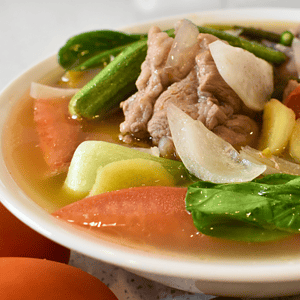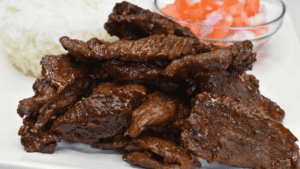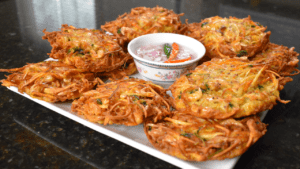Classic Pork Sinigang
Pork Sinigang is a traditional Filipino dish. It is a sour and savory soup made with slow-cooked pork meat, an array of vegetables, and tamarind, which gives the dish its distinct tangy flavor.

Mastering Classic Pork Sinigang: A Flavorful Journey in Filipino Cuisine
In the vibrant tapestry of Filipino cuisine, there’s a dish that stands out not just for its tangy and savory taste but for its warm associations and communal significance. Enter Pork Sinigang, a beloved classic that speaks volumes of Filipino culinary heritage and the art of bringing family and friends together over a shared meal. Whether you’re a home cook looking to explore international flavors or a food enthusiast keen on discovering authentic recipes, mastering Pork Sinigang is a culinary adventure you won’t want to miss.
Introduction to Pork Sinigang
Pork Sinigang, a staple of Filipino dining, is a sour soup that’s known for its distinct tartness, usually achieved using tamarind as a base. The dish typically features pork as the main protein, accompanied by an array of fresh vegetables such as bok choy, okra, eggplant, and long beans. Its complex yet harmonious flavors make it a standout, not just in the Philippines, but worldwide among aficionados of global cuisine.
The Essence of Pork Sinigang
Pork Sinigang symbolizes the Filipino trait of preserving and cherishing flavors that are rich and diverse. At its core, the dish embodies the balance between the sourness of tamarind and the savoriness of the pork, creating a delectably layered taste that is unmistakably Filipino.
Ingredients and Preparation
Before we wade into the cultural roots and myriad versions of this dish, let’s start with the building blocks — the ingredients and the art of its preparation. The key to a great Pork Sinigang is freshness — fresh protein, fresh fruits, and fresh vegetables.
The Must-Have Ingredients
- 2 lbs pork spare ribs, chopped
- 1 lb bok choy
- 150 g daikon, chopped
- 2 medium eggplants, chopped
- 12 pieces long beans
- 2 tbsp fish sauce
- 1 medium onion, chopped
- 10 pieces okra
- 8 cups water
- 1 medium ginger, chopped
- 10 pieces tamarind
- 2 medium tomatoes, chopped
Step-by-Step Cooking Instructions
- In a large pot, bring 8 cups of water to a boil.
- Add the chopped pork spare ribs to the boiling water and let it simmer for 30 minutes.
- Next, add the tamarind pieces. Extract the tamarind juice and discard the pulp and seeds.
- Add the chopped onion, ginger, tomatoes, long beans, eggplant, okra, daikon, and fish sauce to the pot. Allow it to simmer for 5 minutes or until the vegetables are tender.
- Now, add the bok choy to the pot and let the flavors meld together for an additional 2 minutes.
- Serve the dish hot with steamed rice and savor every bite!
History and Cultural Significance
Understanding the cultural significance of Pork Sinigang is as essential as learning its recipe. This dish is a representation of Filipino resourcefulness and the ability to create something delightful from the simplest of ingredients.
Origins and Traditional Methods
The history of Sinigang can be traced back to the traditional home-cooking practices of Filipino families. The classic way of preparing the dish was to use whatever protein and locally available fruits or vegetables to create a hearty stew that could feed a crowd.
Culinary Heritage and Family Traditions
Pork Sinigang holds a special place in the hearts of Filipinos, often being served during family gatherings or festive occasions. It’s a dish that transcends generations, connecting the modern palate to the flavors enjoyed by ancestors.
Variations and Regional Twists
Like many cherished recipes, Pork Sinigang has evolved over time, taking on regional nuances and personal touches. Exploring these variations provides a window into the diversity of Filipino cuisine.
Diving into Regional Variations
From the soured meat of the Ilocanos to the use of guava as the souring agent in Visayan sinigang dishes, each region of the Philippines offers a distinct version of this dish. Some regions even add chili for an extra kick.
Unique Ingredients Across the Archipelago
The vast range of tropical fruits and vegetables in the Philippines has led to unique ingredients finding their way into various iterations of Pork Sinigang. Pea eggplants, taro corms, and unripe mangoes are just a few examples of the diverse elements that add character to the dish.
Tips for Perfecting the Dish
Cooking the perfect Pork Sinigang requires a keen understanding of flavors and the mastery of some key techniques. Here are some tips to ensure that every pot of Sinigang you make is a celebration of authentic Filipino cuisine.
Balance of Flavors
The real magic of Sinigang lies in the perfect balance of sourness, saltiness, and umami. Start with the right amount of tamarind or tamarind juice and adjust the level of fish sauce to taste, always keeping in mind the saltiness of the pork and other ingredients.
Ingredient Quality
Freshness is crucial, especially when it comes to the assorted vegetables in the dish. They should be just cooked, maintaining a hint of crunch, which not only adds texture but also preserves nutrients and enhances the overall dining experience.
Serving Suggestions and Pairings
Pairing Pork Sinigang with the right accompaniments can elevate the meal to a sensory experience. Here are suggestions for side dishes, condiments, and beverages that harmonize beautifully with the dish.
Complementing Sides and Condiments
A crusty loaf of bread, steamed rice, or even a serving of freshly made cornbread can make for a satisfying companion to a bowl of Pork Sinigang. Condiments like fish sauce with sliced chili or soy sauce with calamansi provide personalization to individual servings.
A Harmony of Beverages
To quench the thirst, a glass of cold, sweet calamansi juice is a popular choice. For those interested in traditional pairings, tamarind juice or even a light lager is an excellent match that enhances the dining experience.
Conclusion
Mastering Classic Pork Sinigang is not just about preparing a delicious meal; it’s about immersing yourself in the heritage and traditions that have shaped the Philippines’ culinary identity. It’s a dish that embodies the Filipino spirit — resilient, adaptive, and deeply flavorful. Whether you’re in the Philippines or exploring its cuisine from afar, Pork Sinigang is an invitation to partake in a culinary heritage that is as rich as the flavors in the bowl.Start your flavorful adventure with a pot of Pork Sinigang, gather your loved ones, and savor every spoonful of a dish that is both a testament to the past and a promise for the future of Filipino food.
More Filipino Recipes

Classic Pork Sinigang
Ingredients
- 2 lbs pork spare ribs chopped
- 1 lb bok choy
- 150 g daikon chopped
- 2 medium eggplant chopped
- 12 pieces long beans
- 2 tbsp fish sauce
- 1 medium onion chopped
- 10 pieces okra
- 8 cups water
- 1 medium ginger chopped
- 10 pieces tamarind
- 2 medium tomatoes chopped
Instructions
- In a large pot, bring 8 cups of water to a boil.
- Add the chopped pork spare ribs to the boiling water and let it simmer for 30 minutes.
- Next, add the tamarind pieces. Extract the tamarind juice and discard the pulp and seeds.
- Add the chopped onion, ginger, tomatoes, long beans, eggplant, okra, daikon, and fish sauce to the pot. Allow it to simmer for 5 minutes or until the vegetables are tender.
- Now, add the bok choy to the pot and let the flavors meld together for an additional 2 minutes.
- Serve the dish hot with steamed rice and savor every bite!






















